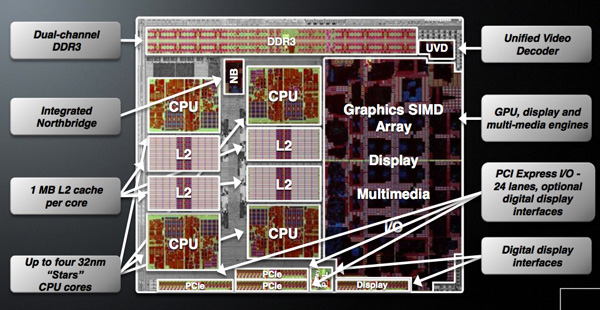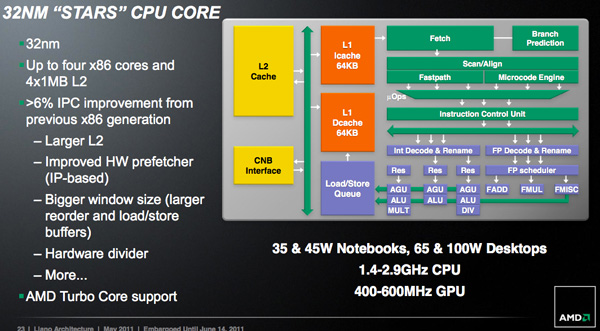The AMD Llano Notebook Review: Competing in the Mobile Market
by Jarred Walton & Anand Lal Shimpi on June 14, 2011 12:01 AM ESTThe Llano A-Series APU
Although Llano is targeted solely at the mainstream, it is home to a number of firsts for AMD. This is AMD's first chip built on a 32nm SOI process at GlobalFoundries, it is AMD's first microprocessor to feature more than a billion transistors, and as you'll soon see it's the first platform with integrated graphics that's actually worth a damn.
AMD is building two distinct versions of Llano, although only one will be available at launch. There's the quad-core, or big Llano, with four 32nm CPU cores and a 400 core GPU. This chip weighs in at 1.45 billion transistors, nearly 50% more than Sandy Bridge. Around half of the chip is dedicated to the GPU however, so those are tightly packed transistors resulting in a die size that's only 5% larger than Sandy Bridge.
| CPU Specification Comparison | ||||||||
| CPU | Manufacturing Process | Cores | Transistor Count | Die Size | ||||
| AMD Llano 4C | 32nm | 4 | 1.45B | 228mm2 | ||||
| AMD Llano 2C | 32nm | 2 | 758M | ? | ||||
| AMD Thuban 6C | 45nm | 6 | 904M | 346mm2 | ||||
| AMD Deneb 4C | 45nm | 4 | 758M | 258mm2 | ||||
| Intel Gulftown 6C | 32nm | 6 | 1.17B | 240mm2 | ||||
| Intel Nehalem/Bloomfield 4C | 45nm | 4 | 731M | 263mm2 | ||||
| Intel Sandy Bridge 4C | 32nm | 4 | 995M | 216mm2 | ||||
| Intel Lynnfield 4C | 45nm | 4 | 774M | 296mm2 | ||||
| Intel Clarkdale 2C | 32nm | 2 | 384M | 81mm2 | ||||
| Intel Sandy Bridge 2C (GT1) | 32nm | 2 | 504M | 131mm2 | ||||
| Intel Sandy Bridge 2C (GT2) | 32nm | 2 | 624M | 149mm2 | ||||
Given the transistor count, big Llano has a deceptively small amount of cache for the CPU cores. There is no large catch-all L3 and definitely no shared SRAM between the CPU and GPU, just a 1MB private L2 cache per core. That's more L2 cache than either the 45nm quad-core Athlon II or Phenom II parts.

Intel's Sandy Bridge die is only ~20% GPU
The little Llano is a 758 million transistor dual-core version with only 240 GPU cores. Cache sizes are unchanged; little Llano is just a smaller version for lower price points. Initially both quad- and dual-core parts will be serviced by the same 1.45B transistor die. Defective chips will have unused cores fused off and will be sold as dual-core parts. This isn't anything unusual, AMD, Intel and NVIDIA all use die harvesting as part of their overall silicon strategy. The key here is that in the coming months AMD will eventually introduce a dedicated little Llano die to avoid wasting fully functional big Llano parts on the dual-core market. This distinction is important as it indicates that AMD isn't relying on die harvesting in the long run but rather has a targeted strategy for separate market segments.
Architecturally AMD has made some minor updates to each Llano core. AMD is promising more than a 6% increase in instructions executed per clock (IPC) for the Llano cores vs. their 45nm Athlon II/Phenom II predecessors. The increase in IPC is due to the larger L2 cache, larger reorder and load/store buffers, new divide hardware, and improved hardware prefetchers.
On average I measured around a 3% performance improvement at the same clock speed as AMD's 45nm parts. Peak performance improved up to 14% however most of the gains were down in the 3—5% range. This is arguably the biggest problem that faces Llano. AMD's Phenom architecture debuted in 2007 and was updated in 2009. Llanos cores have been sitting around for the past 3-4 years with only a mild update while Intel has been through two tocks in the same timeframe. A ~6% increase in IPC isn't anywhere near close enough to bridge the gap left by Nehalem and Sandy Bridge.
Note that this comparison is without AMD's Turbo Core enabled, but more on that later.












177 Comments
View All Comments
ET - Tuesday, June 14, 2011 - link
So, what do you tell them? The only benchmarks of The Sims 3 I could find are pretty old and didn't offer much detail, but I think based on them that high quality would require more than the lowest IGP. (Then again, normal or low quality should probably run fine on anything.)msroadkill612 - Tuesday, August 2, 2011 - link
ta 4 the post - but dont salesmen have a duty to sell them a bit of insurance against the next game fadash9 - Tuesday, June 14, 2011 - link
Bring on the OpenCL apps, excuse me applications- Excel rewritten to take advantage of heterogeneous computing would silence everyone about Star CPU cores. The ball is in the hands of the people (to buy them), then the software developers (to program for them) - that's why Star cores? APU apps neededmsroadkill612 - Tuesday, August 2, 2011 - link
I think it will happen. Big mobs will identify niches that can profit from OGPL & profit from using it - open languages always win in the end.I see fusion server apuS in the future.
FISHRULE - Tuesday, June 14, 2011 - link
What a terrible CPU, who would want something that performs like a Phenom in a new computer circa 2011. The future might be fusion AMD, but you sure as heck aren't part of the future anymore.jabber - Tuesday, June 14, 2011 - link
90% of laptop owners wouldnt know if they were using a Brazos or an i5 in their laptops.The only real differential is in transcoding, ripping etc. and very few folks in the real world actually do that. Especially on laptops.
Price is far more important than outright performance. Has been for some time now.
RussianSensation - Tuesday, June 14, 2011 - link
False. My gf doesn't know anything about computers. But she somehow knew that Intel makes the best mobile CPUs even before asking me what to get. Clearly Intel marketing > AMD's. All of my current friends who just bought a computer all went with i3/i5/i7 processors only because they "heard" Sandy Bridge is the fastest CPU around.Llano is nothing more than a Phenom with a faster GPU. Phenom already didn't sell well against C2D/C2Q/Core i7 (1st) gen and isn't getting any better against SB. The only way AMD is gaining market share is if they ship cheap laptops with Llano to users for whom the price of a laptop is the most important factor.
ET - Tuesday, June 14, 2011 - link
Well, you have pretty computer literate friends. Most people I know would have no idea what Sandy Bridge is, probably not even what i3 and i5 are, and would only buy i3 or i5 because: a) AMD had very little market presence until now; b) I'd recommend them. That said, most of the people I know have no idea that AMD exists and is making CPU's (I mention it occasionally, and they're always surprised, so I guess it doesn't register), so it does look like AMD's marketing is pretty crappy.That said, I think that your analysis of why Llano will fail isn't right. For most people the CPU power really doesn't matter that much. They'd have no idea if i3 or Llano is better, and most likely won't be able to tell the difference in practice (unless they run a game for which the HD 3000 is unsuited). Sure Llano is for the low end market, but that's where most sales are, and it's certainly much improved in terms of power usage, which is an important enough measure to help it gain market share.
RussianSensation - Tuesday, June 14, 2011 - link
You are probably right that most people won't tell the difference between a Llano or an i3/i5/i7. But to them the perception of knowing that they have a slower CPU is what matters. One of my friends was building a PC for browsing the net only. I told him he'd be perfectly fine with a $100 CPU but he insisted that the system must have Sandy Bridge because it's the latest modern CPU. I gave up trying to convince him that his internet browsing experience will be more limited by his ISP latency and speed rather than CPU performance.So as long as AMD convinces the average consumer that Llano is at at least as good, they will do well. The problem is AMD's marketing department is worse than a 1st year undergrad student studying marketing in business school. They think if they pay millions of dollars to put AMD on F1 cars, people will notice?
You made a very important point - a lot of people don't even know what AMD is or that there is another competitor to Intel. Imagine if GM, Ford or Chrysler made cars that were more reliable than Honda or Toyota. It would still be a while until the average consumer would abandon the Japanese brands since the perception of reliability would lag behind reality. AMD has this similar problem with their CPU brands, which only marketing can fix.
jrs77 - Tuesday, June 14, 2011 - link
Really... that's rather unimpressive.The GPU of Llano beats intels HD-graphics in games, what a surprise. But how many people do I know personally, that play games on their laptops anyways? Laptops are primarily used as mobile office-computers and they do still rely more on CPU-performance.
From all the experience I've made the HD3000 graphics of mobile SNB CPUs are perfectly fine for all tasks I throw at them (excluding games). So the question is, why would I buy a Llano-based laptop instead of a SandyBridge one?
Llano doesn't offer better battery-life so the only reason might be the price, but with i5-2xxx laptops starting at $600 I really don't see alot of competition there for intel, if we're talking anything else then gaming.